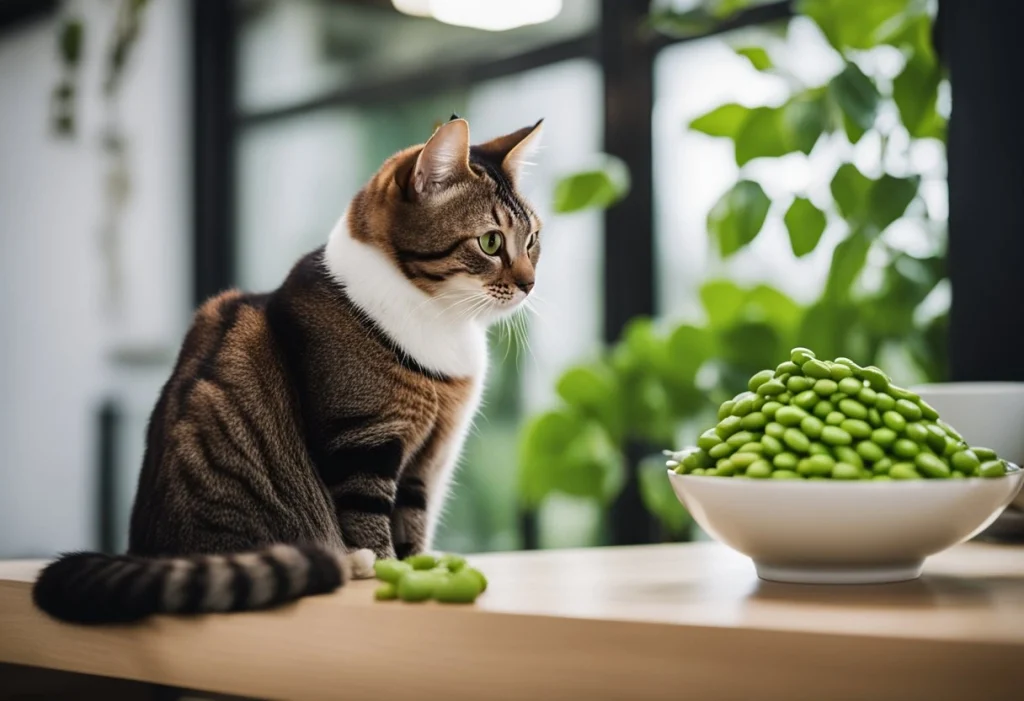Can Cats Eat Edamame? Understanding the Safety and Nutritional Impact for Your Feline
By: Lana Koh

The information in this article is intended to educate cat parents and is not a substitute for veterinary guidance. In case of any concerns about your cat’s health, please talk with your veterinarian.
Edamame is a popular snack among humans, but many cat owners wonder if their pets can indulge as well. Cats can eat edamame without experiencing immediate toxicity, though it should not be a regular part of their diet. Understanding what foods are safe for cats is essential for any pet owner wanting to provide a balanced diet.
While edamame is non-toxic, it is important to consider that cats are obligate carnivores. This means their bodies are designed primarily for a meat-based diet. Introducing plant-based foods like edamame may not solely benefit their health and could lead to digestive issues in some cases.
Before adding any new food to a cat’s diet, it is advised to consult with a veterinarian. This ensures the safety and health of the pet, so owners can make informed choices about their furry friends’ diets.
Key Takeaways:
- Edamame is safe for cats to eat in small amounts.
- Cats mainly thrive on a meat-based diet.
- Consulting a veterinarian is crucial before changing their diet.
Also Read: Can Cats Eat Mochi?
Exploring Edamame: Can Cats Consume Soybeans?
Video Credit: Charming Pet Guru Official
Edamame, or immature soybeans, can spark curiosity among cat owners about their safety for feline consumption. This section examines the nutritional profile of edamame and its potential health benefits for cats, ensuring pet owners have the right information.
Nutritional Profile of Edamame
Edamame is packed with valuable nutrients. It contains a good amount of protein, which is essential for muscle development. A 100-gram serving of edamame offers about 11 grams of protein.
Additionally, it is rich in fiber, which helps with digestion. Other nutrients include:
- Vitamins: High in vitamin K, folate, and vitamin C.
- Minerals: Provides iron, calcium, and magnesium.
For cats, a small amount of edamame can contribute to their nutritional needs. However, cats are obligate carnivores, so their primary diet should focus on meat rather than plant-based proteins.
Also Read: Can Cats Eat Mushrooms?
Potential Health Benefits for Cats
Introducing edamame into a cat’s diet should be done with caution. While it is non-toxic to cats, there are some potential benefits and risks.
Benefits include:
- Fiber Content: Aids in digestion and may help prevent hairballs.
- Protein Source: Can be a supplemental protein option, though not a replacement for meat.
Risks may involve:
- Digestive Upset: Some cats may experience diarrhea or vomiting after consuming edamame.
- Allergies: In rare cases, edamame could trigger food sensitivities.
Consulting a veterinarian before adding edamame to a cat’s diet helps ensure their health and well-being.
Also Read: Can Cats Eat moths?
Understanding Cats’ Dietary Needs
Cats have specific dietary needs that must be met for optimal health. As obligate carnivores, they rely heavily on protein from animal sources. Understanding their protein requirements and the risks associated with feeding them legumes, like edamame, is crucial for their well-being.
Cats’ Protein Requirements
Cats need a high amount of protein in their diet, typically around 25-30% of their total caloric intake. This protein comes mostly from meat. Amino acids, particularly taurine, are vital for various bodily functions like heart health and vision.
Unlike dogs, cats cannot produce certain essential amino acids. Therefore, they rely on their diet to provide these nutrients. A lack of adequate protein can lead to serious health issues including muscle loss and weakened immune function.
It is important for cat owners to ensure their pets consume high-quality protein sources. Foods with high protein content, such as chicken, turkey, and fish, are beneficial. These sources supply the amino acids that cats require for their overall health.
Risks Associated With Legumes for Cats
While edamame and other legumes are not toxic to cats, they pose certain risks. Cats’ gastrointestinal systems are not designed to properly digest plant-based proteins. Eating legumes may lead to digestive upset, including vomiting or diarrhea.
Legumes, including edamame, are high in carbohydrates and contain fibers that may not benefit cats. Their bodies primarily thrive on animal-based proteins. Regularly feeding legumes can upset their nutritional balance and lead to health issues.
Owners should be cautious about offering legumes in any form. If a cat shows signs of discomfort after eating edamame or similar foods, it is best to consult a veterinarian. Prioritizing protein-rich, meat-based diets is essential for feline health.
Read: Can Cats Eat Tofu?
Common Concerns and Toxic Foods for Cats
Pet owners often worry about what foods are safe for their cats. Certain human foods can be harmful, and knowing which ones to avoid is important for a cat’s health.
The Dangers of Garlic and Onion
Garlic and onion are both toxic to cats. Even small amounts can lead to serious health issues. These foods contain compounds that can damage red blood cells. This condition is known as hemolytic anemia.
Symptoms of garlic and onion poisoning include vomiting, diarrhea, weakness, and lethargy. If a cat eats these foods, it is crucial to seek veterinary attention immediately.
Safe Alternatives to Edamame and Beans
While edamame is not toxic, there are safer alternatives for cats. Cooked kidney beans can be given in small amounts. They provide protein and fiber without harmful effects.
Cooked chicken (boneless and unseasoned), turkey, or small pieces of fish (like salmon or tuna, packed in water) provide essential amino acids like taurine that cats need. Freeze-dried meat treats or commercial cat treats formulated for feline nutrition are also excellent options. Avoid processed human foods and always check for bones, spices, or additives that could harm your cat.
For plant-based alternatives, small amounts of cooked pumpkin or steamed carrots can be given occasionally for fiber, but these should never replace meat in a cat’s diet. If your cat enjoys chewing, cat grass (wheatgrass or oat grass) is a safe, digestible option that aids digestion and satisfies their natural urge to nibble. Always introduce new foods gradually and monitor for any adverse reactions like vomiting or diarrhea. When in doubt, consult your veterinarian for personalized recommendations based on your cat’s health and dietary needs.
Read: Can Cats Eat Dragon Fruit?
Consulting With a Veterinarian
Before introducing edamame or any new food into your cat’s diet, consulting a veterinarian is essential. Cats have unique dietary needs, and what works for one may not suit another. A vet can assess your cat’s health, potential allergies, and digestive tolerance to plant-based foods like edamame.
Veterinarians can also recommend safer alternatives if your cat shows interest in human foods. They may suggest high-protein, meat-based treats that align better with feline nutrition. Professional guidance ensures that any dietary changes support your cat’s well-being rather than risking digestive upset or nutrient deficiencies.
Interesting Read: Why does my cat’s breath smells like fish?
Frequently Asked Questions
Conclusion
While edamame isn’t toxic to cats, it’s far from an ideal snack. Cats thrive on meat-based diets, and plant-based proteins like soy offer little nutritional value. Occasional, plain edamame in small quantities may be harmless, but it shouldn’t replace high-quality cat food.
Before sharing human foods with your feline, always prioritize their carnivorous needs and consult a vet. A balanced, species-appropriate diet ensures your cat stays healthy and happy—without unnecessary risks from unfamiliar treats.

About the Author
Lana Koh
Lana is a passionate cat lover with years of experience caring for her feline companions. As a dedicated volunteer at animal shelters, she’s gained valuable insights into the world of cats. Lana channels her love and knowledge into writing informative and engaging articles for fellow pet owners, covering topics like cat health, nutrition, grooming, behavior, and the special bond we share with our feline friends.
